Astronomy in the 18th Century, longitude, fuzzy blobs and the astronomers drinking song
Reflector telescopes
To avoid the problems arising by the use of glass lenses in refractors, mirrors could be used - to make a reflector telescope. Light from the stars passes down the telescope to the concave surface of a mirror at the far end. From this, the primary mirror, the light is reflected back to a focal point down the telescope. If the telescope was big enough, the astronomer could perch here.
(As in the 200 inch Hale telescope finished after World War 2, where the astronomer perched in a cage to look after the camera and was stuck there all night with radio, chocolate bars, thermos of tea, and by the end of his shift, a straining bladder.)
In a smaller telescopes, the focussed image must be directed to an eyepiece outside. There are different ways of doing this. Caroline and William Herschel, who built the largest reflecting telescopes in the 18th century, designed a slightly tilted mirror so the focal point met the eyepiece at the end of the telescope where the observer perched on a platform. This was still only practical for large telescopes as the astronomer would obscure too much of the light passing down the telescope to the mirror.
The first reflecting telescope was invented by James Gregory (1638-1675) who published his idea in his "Optima Promota" in 1663, while till living in Aberdeen. Soon after he went to Padua University. In 1669, he was made Professor of Mathematics at the University of St. Andrews. In 1674 he was a professor at Edinburgh University. A year later he was suddenly tragically struck with blindness while showing his students how to observe Jupiter through a telescope. In the Gregorian reflector the image is reflected back from a concave mirror through a gap in the primary mirror to the eyepiece.
Robert Hooke (1635-1703) commissioned instrument maker, Richard Reeve, to make a telescope like Gregory's. By 1664, Hooke had a working model telescope. But then Richard Reeve was arrested for murdering his wife.
In 1671, Newton showed his design for a reflecting telescope to the Royal Society. In Newton's reflector, light is collected by a concave mirror at the end of the tube, and bounced back to a flat mirror which is at an angle of 45 degrees. This directs the light to focus at the eyepiece at the side of the tube.
In 1672, Cassegrain submitted two scientific papers to the Academy of Sciences in Paris. One was on the megaphone, the other was his own design for a reflecting telescope. This is similar to Gregory's but with a convex secondary mirror. Not only can this design be more compact, it has much less spherical aberration (the distortion and blurring caused by two mirrors or lenses). From it developed telescopes like the 1970s Isaac Newton.
Although the reflector avoided many of the problems associated with refracting telescopes, it had many technical problems of its own. Which is why Gregory, Hooke and Newton with instrument maker Christopher Cock, spent so long on so many ideas that did not work in practice.
One problem was that the metal, speculum, an allow of copper and tin, used for the mirrors, tarnished and distorted very rapidly. It had to be repolished many times, which meant the whole telescope had to be set up again each time.
In his "Optick" (1704), Newton describes a telescope with a back-silvered glass primary mirror and a prism for the flat mirror. This would not have worked.
In the 1720s, John Hadley with his brothers George and Henry, built the first useful reflecting telescopes, Gregorian and Newtonian.
The light gathering power of an optical telescope is proportional to the square of the diameter of its primary mirror. So a 200 inch would have been able to see galaxies and stars four times fainter (1.5 mag) or twice as far away, as the 100 inch model. The larger the telescope the more could be seen, the limitations were the technology available to maintain precision.
The mirror of the 200 inch Hale telescope took many years to make from Pyrex glass which is resistant to temperature changes, with an aluminium reflecting surface. The 10-metre mirror of the Keck Telescope, is made up from 36 hexagon segments. Modern telescope mirrors need not be made in one piece as they are adjusted by computer.
But mirror problems have not always been overcome. The distortions of the l,500 million dollar 2.4 metre Hubble telescope were discovered only after it had been launched into orbit in 1990. It cost many more millions to design a tiny system of mirrors to correct the image distortions of the primary mirror and fit this on a service mission by shuttle. But it was worth it for the images it sent back gave us new information about the formation of stars and solar systems, the formation of galaxies and the true nature of black holes which has gen us new insight and drastically changed and increased our knowledge of the universe.
With the increased trade and colonization of countries less technologically developed than those of Europe (ie men with spears defending their country from men with guns did not stand a chance) - then knowing where you were - and the position of your new harbour so other ships could find it - was even more pressing. Finding your latitude, how far south or north you were was easily accomplished by the changing positions of the stars or the height of the sun. Finding your longitude - how far east or west you were - was not so easy. New ideas based on astronomy, and new technology to make it easier, were being invented all the time. In the 18th century, the technology was at last starting to meet the challenge, of not only fixing a position on land, but the much more difficult need, to fix your position while on a ship tossing about on the open seas.
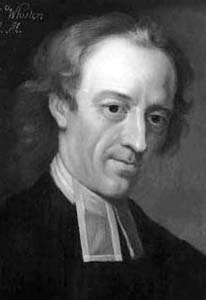
Whiston and Ditton
In 1713, two English scientists came up with a solution to the problem of finding longitude at sea. The Rev. Humfrey Ditton was a mathematics master at Christ's Hospital School. The Rev. William Whiston (pictured) had been Isaac Newton's successor as Lucasian Professor of Mathematics at Cambridge. He is called "wicked" in the song below because he was sacked from his position for his "heretical "views. In his books, he had suggested natural causes for the Earth's origins, and that Noah's Flood in the Bible, might have been caused by a comet passing near the Earth, and was one of a number of naturally caused catastrophes.
The two ancient English universities Oxford and Cambridge, were at this time, mainly concerned with turning out Church of England clergymen. To get a degree you also had to be ordained. (Edmund Halley had not finished his degree for this reason, and later the Archbishop of Canterbury tried to prevent him becoming appointed Savillian Professor of Mathematics at Oxford. He too, had tried to calculate the age and origin of the Earth by scientific means).
This is why John Harrison speaks (with contempt) of "Oxford and Cambridge education" and "priests and scholars". Scientific progress in the 18th century in England did not come from its universities.
So however good Whiston and Ditton's idea for finding longitude at sea was, it would never be acceptable, as they had fallen foul of the establishment. Their idea proposed that light-ships be anchored in certain positions along the main ocean routes. At midnight precisely, these ships would fire a shell to a height of 6,440 feet. This, according to the authors' calculations would enable the spark and explosion to be seen and heard a distance of 85 miles, and thus provide a method by which the time aboard ships could be corrected and the position checked.
Whiston and Ditton published details of their scheme in "The Guardian" of 14th July 1713, and "The Englishman" of 10th December 1713. In 1714, they brought out a book called "A New Method For Discovering The Longitude".
The basic principle of their idea - that a ship could fix its position from time signals - was excellent. When the technology to make it feasible become available in the 20th century it did come to be the established method, first with radio time signals, then satellite navigation. Whiston and Ditton's idea was very popular with the general public who felt it was about time the government invested some funds and effort into preventing the appalling losses of ships, cargo, passengers and crew. But the establishment did not like Whiston and Ditton and ridiculed their schemes. Ditton died, disappointed, in 1715. After the death of Queen Anne, the heresy charge against Whiston was dropped.
A rude song was published about Whiston and Ditton called:
"Ode, for Musick. On the Longitude":
The Longitude mist on By wicked Will Whiston And not better hit on By good Master Ditton. So Ditton and Whiston May both be bep-st on; And Whiston and Ditton May both be besh-t on. Sing Ditton, Besh-t on; And Whiston Bep-st on. Sing Ditton and Whiston, And Whiston and Ditton, Besh-t and Bep-st on, Bep-st and Besh-t on.
John Harrison knew this song well, for he applied its sentiments to his own comments about the members of the Board of Longitude, in his book, written many years later.
The Board of Longitude
The publicity given to Whiston and Ditton had brought to public attention the lack of progress in finding a solution to the longitude problem, the need for someone to pressure for government action. They suceeded in getting a bill passed in Parliament:
"Towards the latter End of April, Mr. William Whiston, M.A. and Mr. Humphry Ditton, Master of the New Mathematical School in Christ's Hospital, London, having as they thought, found a new Method, for discovering the Longitude both at Land and Sea, were encouraged by some Gentlemen to apply themselves to the House of Commons for a Reward, which they did in the following Paper, or Petition.
Petition of Mr. Whiston and Mr. Ditton, for a Reward for Discovery of the Longitude.
'Whereas her Majesty has been pleased, this very Sessions of Parliament, particularly to recommend the Improvement of the Trade and naval Force of Great Britain, from the Throne: And whereas it is known, that nothing can be either at home or abroad, more for the common Benefit of Trade and Navigation, than the Discovery of the Longitude at Sea which has been so long desired in vain, and for want of which so many Ships and Men have been lost: Whereas also a Proposal for that Purpose has now been offered to the World for some Time, and has met with Approbation among some of the best Judges, to whom it has been privately discovered, but, for Want of any suitable Encouragement, could not hitherto be communicated to the Public: It is humbly desired, that a Bill, or Clause of a Bill, may be brought in this Parliament, to appoint a suitable Reward, for such as shall first lay before the Public, any sure Method for the Discovery of that Longitude; to be then due, when the most proper Judges, who may be appointed in the Bill, shall declare that such Method is both true in it self, and is also practicable at Sea; That the lowest Reward may be allotted to the discovering the same within one whole Degree of a great Circle, or seventy measured Miles; a greater to the discovering it within one half; and a still greater to the discovering it within one Quarter of that Measure: And that withal, if it be thought fit, proper Rewards may be also allotted to such as shall afterward make any farther considerable Improvements for the perfecting so important a Discovery. This is the humble Desire of the Authors of this Invention, as well as of many others; who are unwilling that this their Native Country of Great Britain should lose the Honour and Advantage of its first Discovery, Practices and Encouragement.' April 29, 1714.
Resolutions of the Committee thereupon.
The House appointed a Committee, to consider what Encouragement was fit to give to such as should find out the Longitude; which Committee, having on the 4th of June, asked Mr. Whiston and Mr. Ditton some Questions, in the Presence of Sir Isaac Newton, Dr. Halley, and some other celebrated Mathematicians, came to these two Resolutions, 1. 'That it is the Opinion of this Committee, that a Reward be settled by Parliament, upon such Person or Persons, as shall discover a more certain and practicable Method of ascertaining the Longitude, than any yet in Practice, and that the said Reward be proportioned to the Degree of Exactness to which the said Method shall reach.' 2. That the House be moved, that Leave be given for a Bill to be brought in accordingly.On the 25th May 1714, a petition was delivered to Parliament by "Captains of Her Majesty's ships, Merchants of London, and commanders of Merchant-Men" demanding that research into solving the problem of finding the longitude be encouraged by offering a substantial award.
In June 1714, a special parliamentary committee was set up to investigate the longitude problem. They recommended:
"That a reward be settled by Parliament upon such Person or Persons as shall discover a more certain and practicable method of ascertaining the Longitude than any yet in practice.
The committee had said:
"The House proceeded to take into Consideration the Report from the Committee, who were to consider of what Encouragement was fit to be given to such as should find out the Longitude at Sea.
That it appeared to the said Committee as followeth; viz.
Mr. Ditton and Mr. Whiston, being examined, did inform the Committee, That they had made a Discovery of the Longitude; and were very certain, that the same was true in the Theory; and did not but doubt that, upon due trial made, it would prove certain and practicable at Sea.
That they had communicated the whole History of their Proceedings towards the said Discovery to Sir Isaac Newton, Dr. Clark, Mr. Haley, and Mr. Cotes; who all seemed to allow of the Truth of the Proposition, as to the Theory: but doubted of several Difficulties that would arise in the Practice.
Sir Isaac Newton, attending the Committee, said That for determining the Longitude at Sea, there have been several Projects, true in the Theory, but difficult to execute:
- One is, by a Watch to keep Time exactly: But, by reason of the Motion of a Ship, the Variation of Heat and Cold, Wet and Dry, and the difference of Gravity in different Latitudes, such a Watch hath not yet been made:
- Another is, by the Eclipses of Jupiter's Satellites: But, by reason of the Length of Telescopes requisite to observe them, and the motion of a Ship at Sea, those Eclipses cannot yet be there observed.
- Another is, by the Place of the Moon: But her Theory is not yet exact enough for this Purpose; It is exact enough to determine her Longitude within Two or Three Degrees, but not within a Degree:
- A Fourth is, Mr. Ditton's Project: And this is rather for keeping an Account of the Longitude at Sea, than for finding it, if at any time it should be lost, as it may easily be in cloudy Weather: How far this is practicable, and with what Charge, they that are skilled in Sea-affairs are best able to judge: In sailing by this Method, whenever they are to pass over very deep Seas, they must sail due East or West, without varying their Latitude; and if their Way over a Sea doth not lie due East, or West they must first sail into the Latitude of the next Place to which they are going beyond it; and then keep due East, or West till they come at that Place:
In any of the Three first Ways, it may be of some Service to find the Longitude within a Degree; and of much more Service to find it within Forty Minutes, or Half a Degree, if it may be; and the Success may deserve Rewards accordingly:
In the Three first ways there must be a Watch regulated by a Spring, and rectified every visible Sun-rise and Sun-set, to tell the Hour of the Day, or Night: In the Fourth Way, such a Watch is not necessary: In the First way, there must be Two Watches; this, and the other mentioned above:
In the Fourth Way, it is easier to enable Seamen to know their Distance, and Bearing from the Shore, 40, 60, 0r 80, Miles off, than to cross the Seas; and some Part of the Reward may be given when the First is performed on the Coast of Great Britain, for the Safety of Ships coming Home; and the rest, when Seamen shall be enabled to sail to an assigned remote Harbour without losing their Longitude, if it may be.
Dr. Clarke said, That there could be no Discredit arise to the Government, in promising a Reward in general, without respect to any particular Project, to such Person or Persons who should discover the Longitude at Sea.
Mr. Halley said, That Mr. Ditton's Method for finding the Longitude did seem to him to consist of many Particulars, which first ought to be experimented, before he could give his Opinion; and that it would cost a considerable sum to make the Experiments; but what the Expence would amount to, he could not tell.
Mr. Whiston affirmed, That the undoubted Benefit which would arise on the Land, and near the Shore, would vastly surmount the Charges of the Experiments.
Mr Cotes said, That the Project was right in the Theory near the Shore; and the practical Part ought to be experimented And, upon the whole Matter, the Committee came to these Resolutions; viz.
Resolved, That it is the Opinion of this Committee, That a Reward be settled by Parliament upon such Person or Persons as shall discover a more certain and practicable Method of ascertaining the Longitude, than any yet in Practice; and the said Reward be proportioned to the Degree of Exactness to which the said Method shall reach.
Resolved, That it is the Opinion of this Committee, That the House be moved, That Leave be given for a Bill to be brought in accordingly"
It was not a new idea, other countries countries had offered prizes for a satisfactory method for finding longitude.
As well as the serious contenders there were also the nutters. The Board of Longitude had to consider them all at its meetings.
Among the inmates of the lunatic asylum in Hogarth's Rake's Progress are those who have gone mad trying to calculate a method of finding longitude.
One of Bradley's important discoveries was nutation - the wobble in the precession of the Earth's axis caused by the gravitational effects of the Moon. Other astronomers discovered more about this effect. It was D'Alembert who found this movement of the Earth, which caused the aberration in the positions of the stars was due to the Moon's orbit round the Earth.
Jean-le-Rond D'Alembert was found in 1717 on the steps of the church of St.Jean-le-Rond in Paris. Amongst his published work were mathematical treatise on the gravitational problems of three bodies or more. For although Newton's laws work well with two bodies, as Newton himself realized, each body in the solar system must be subjected to the gravitational effects of other bodies in the Solar System. The Earth, for instance, is effected both by the Sun and the Moon, and also in a much smaller way by the other larger bodies in the Solar System. Newton had not succeeded in solving this problem mathematically, now others tried to provide a mathematical solution to the three body problem.
Alexis Claude Clairaut, also from Paris, born in 1713, was particularly concerned with gravitational effects of the Earth and Moon and of the planets. He predicted the date of return of Halley's comet, taking into consideration the influences of Jupiter and Saturn. (He was just over a month out).
Leonhard Euler, was born in Basle in 1707. His family was friends with the Bernoulli family of mathematicians. He was employed at the Academy of Sciences St.Petersburg, but from 1741 to 1766 he worked for Frederick the Great in organising the Academy of Sciences in Berlin. In 1735 he lost the sight in one eye, and after returning to Russia, went completely blind. But he continued working as a mathematician.
Euler, Clairaut, and D'Alembert, each found a solution to the three body problem and produced a lunar theory resulting in lunar tables.
One of these was Pierre le Roy (1717-1785), the other was Ferdinand Berthoud (1727-1807).
Pierre le Roy was born in Paris into a family of established clockmakers. He became Horologer du Roi (clockmaker to the King). In the 1750s he started designing and making sea-clocks. His third or fourth design, which was of compact size and spring driven - a "montre-marine", was presented to King Louis XV in August 1766.
Trials began on it the following year together with a second "montre-marine" le Roy had made.
Ferdinand Berthoud was born in Switzerland. He worked in Paris, his workshop was down the same street - the rue de Harlay, as le Roy. Berthoud's books on horology made him famous in Britain as well as France and he was made a member of the Royal Society in 1764. Berthoud was also working on the development of a "montre-marine" in the 1750s. His work and reconstruction of him in his workshop can be seen in the Conservatoire National des Arts et Metiers. Berthoud's chronometers were successful in trials. In 1763 and 1766 he was sent by the French Government to London to examine John Harrison's fourth and successful sea-clock. This was seen by Harrison as industrial espionage. Which of course it was.
In 1766 Berthoud received a commission from Louis XV for two "horloge-marine" and in 1770, he was appointed "Horloger Mechanicien du Roi et de la Marine".
Both le Roy's and Berthoud's chronometers were larger than Harrison's fourth machine. They were competing not only with Harrison and other British clockmakers, but each other, leading to bitter rivalry.
At stake was the chance of lucrative commissions supplying the navy and merchant shipping. Berthoud was to be the winner as his improved chronometers eventually went into production.
More on longitude and the 18th century instrument makers in:John Harrison and the Problem of Longitude.

James Bradley and the Moon
James Bradley was born in 1693 (so he was the same age as John Harrison with whom he was to clash). His Oxford degree was in theology, but his uncle, James Pound - also a clergyman, who was rector of Wanstead (in East London) was a keen amateur astronomer. Bradley lived with his uncle and aunt and shared with them and visitors like Edmund Halley, their astronomical investigations, such as finding the distance of Mars.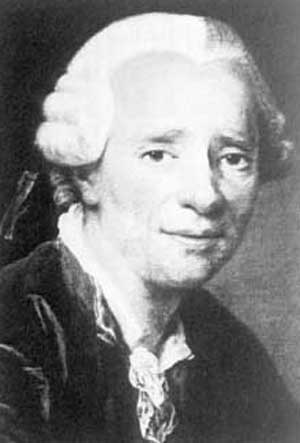
The Moon's Orbit and the three body problem
The Rival Clockmakers of Paris
By the 18th century the term "chronometer" was beginning to be used for clocks or watches that could be used for navigation at sea. They were still also called "sea-clocks" or in French "horloges-marine" or for the spring-driven watches "montres-marine. The development of a "montre-marine" was to lead to bitter rivalry between two Paris clockmakers.Transit of Venus
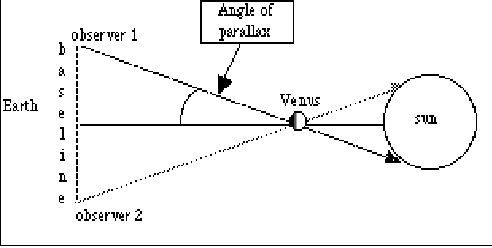 Because Mercury and Venus have orbits between us and the sun, we can only see them either just before dawn or just after sunset. The exception is on the rare occasions when their orbits lie in direct line of sight between us and the sun - so we can see them as a little black dot crossing the sun's disk. But we could only see that after the invention of the telescope, when it could be used to project the image of the sun onto a white card on which the transit could be viewed.
Because Mercury and Venus have orbits between us and the sun, we can only see them either just before dawn or just after sunset. The exception is on the rare occasions when their orbits lie in direct line of sight between us and the sun - so we can see them as a little black dot crossing the sun's disk. But we could only see that after the invention of the telescope, when it could be used to project the image of the sun onto a white card on which the transit could be viewed.
By timing the exact moments that the planet entered and left the Sun's disk, from different places on Earth, it was thought possible, by using parallax, to determine the distance of the Earth from the Sun, and use that as a baseline, the Astronomical Unit, to find the distance of other objects in the Solar System, and the nearest stars. Once the distance of the Earth to the Sun was known, the comparative distances of other bodies in the solar System and nearby stars could be calculated. It would also be possible to determine the longitude of the position of the observer.
The transit of Mercury occurs more often than the transit of Venus and had been used to fix the longitude of some places, as had been suggested by Halley. But as the transit of Venus is rarer, major international preparations were made for astronomers despite political problems and even wars, to travel to remote parts of the world to observe the transits of Venus in 1761 and 1769. They knew a similar opportunity would not re-occur again until 1874 and 1882, then 2004 and 2012. The astronomers had some amazing and awful adventures on their travels to their destinations in Canada, Tahiti, South Africa, Central Siberia, India, Mexico, and other far-flung parts of the Earth.
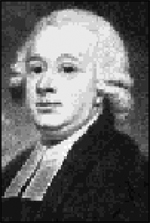 In 1761, Nevil Maskelyne was sent to St.Helena in the Atlantic Ocean, setting out in January to arrive in time for the June transit. Maskelyne was to have been accompanied to St. Helena, by Charles Mason, an astronomer at the Royal Observatory, Greenwich, but Mason was sent instead, with Jeremiah Dixon to Bencoolen in Sumatra. Mason and Dixon had barely started out when a French frigate in the Channel attacked their ship. They set out again, the Royal Society who sponsored the expedition refused to admit they now had no chance of getting to Sumatra in time. When they reached Cape Town, they heard that Bencoolen had been taken by the French, so they remained in South Africa. It was as well, for no other observations were made in the South Atlantic. Maskelyne, with astronomer Robert Waddington on St.Helena, had a cloudy day.
In 1761, Nevil Maskelyne was sent to St.Helena in the Atlantic Ocean, setting out in January to arrive in time for the June transit. Maskelyne was to have been accompanied to St. Helena, by Charles Mason, an astronomer at the Royal Observatory, Greenwich, but Mason was sent instead, with Jeremiah Dixon to Bencoolen in Sumatra. Mason and Dixon had barely started out when a French frigate in the Channel attacked their ship. They set out again, the Royal Society who sponsored the expedition refused to admit they now had no chance of getting to Sumatra in time. When they reached Cape Town, they heard that Bencoolen had been taken by the French, so they remained in South Africa. It was as well, for no other observations were made in the South Atlantic. Maskelyne, with astronomer Robert Waddington on St.Helena, had a cloudy day.
Jean-Baptiste Chappe d'Auteroche, an astronomer at the Paris observatory, was invited to observe the transit from Tobolsk in Western Siberia. He had to travel overland, right through the winter, to reach Tobolsk in time for the transit on June 6th. On the way he had to stay with poverty stricken peasants in grim conditions. Fortunately the big day dawned bright and clear. He asked to go somewhere sunny for the 1769 transit. He was sent to Southern California but died in an epidemic soon afer observing the June 3rd transit.
For the 1769 transit of Venus, astronomer William Wales also asked to be sent somewhere warm and not too remote. He was sent to Hudson Bay.
Meanwhile Captain James Cook was sent in his specially modified research ship to observe the transit of Venus in Tahiti.
Among the other scientific work done was the collection of local animal and plants. This was done by Joseph Banks (more information by Rose).
The next two transits were in 1874 and 1882. Astronomers travelled for the 1874 transit to Hawaii, New Zealand, New Caledonia, Australia, Tasmania, Japan, Eastern Siberia, China, Kerguelen, Persia, the Seychelles, Southern Europe, Egypt, etc. A French expedition stopped off on their way to view the 1874 transit in Japan, in Thailand to observe the 1868 eclipse of the sun at the invitation of King Mongkut. More on this eclipse to come.
The 1882 transit is notable for having a number of women astronomers making the observations, and excellent photographs.
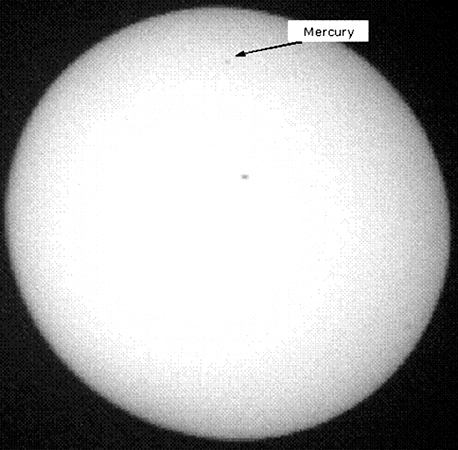
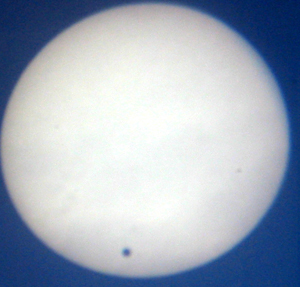 As you can see the transit of Venus is likely to be a once in a lifetime event so we were lucky this time - early morning June 8th 2004 for not only did we get the opportunity to see this - just over a year after we could observe the transit of Mercury on the 7th May 2003, but we could observe both early in the morning from our own back garden. No need for expensive expeditions. Or expensive equipment. Or even time off work. In fact the transits now have little scientific use - but are still fascinating to observe.
As you can see the transit of Venus is likely to be a once in a lifetime event so we were lucky this time - early morning June 8th 2004 for not only did we get the opportunity to see this - just over a year after we could observe the transit of Mercury on the 7th May 2003, but we could observe both early in the morning from our own back garden. No need for expensive expeditions. Or expensive equipment. Or even time off work. In fact the transits now have little scientific use - but are still fascinating to observe.
- More on the history and observations of the transit of Mercury
- More on the history and observations of the transit of Venus
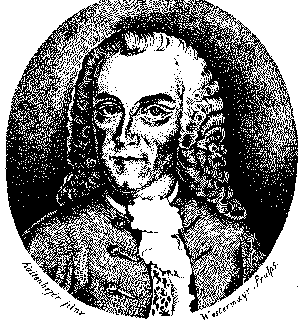
Tobias Mayer (1723-1762)
Tobias Mayer was an astronomer who worked for the Homann Cartographic Bureau in Nuremberg, and was employed in established accurate coordinates for maps. For this he used the Moon's eclipses and occultations of stars by the Moon. Hence his interest in mapping the Moon and in reliable lunar tables.
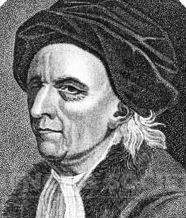 In this work he was helped by his correspondence with Euler.
In this work he was helped by his correspondence with Euler.
In 1751 Mayer was appointed professor of mathematics and political economy at Göttingen University and in 1754 was put in charge of the observatory. By this time his lunar tables were ready and he sent them to England to submit them for the award offered by the Board of Longitude. Mayer could see that these tables would be of use in calculating longitude by the lunar distance method.
Publication of Mayer's Lunar Tables
Mayer died of septicaemia in 1762. His wife brought the latest edition of his lunar tables to the Board of Longitude in London, to be assessed for the award. In 1763, Maskelyne published them in his book" The British Mariner's Guide". Mayer's name as author of the tables does not appear on the title page. Maskelyne gives the impression that it is all his own work.
Later Charles Mason published a Revised Version of Mayer's lunar tables. He did give Mayer full credit as the original author.
Mayer's widow received £3,000 in 1765 from the Board of Longitude who also paid Euler a much smaller sum in recognition of his contribution.
The Lunar Distance Method of Finding Longitude
One of the methods used to find longitude, at land or sea, was to measure the angle between the moon and a star and to work out the longitude by referring to an almanac.The angle continually changes as the moon appears to move across the sky relative to the stars, so each angle represents a particular moment of time. This is called the lunar distance method. It was suggested by Johann Werner in 1514 but the idea had been around for a long time. The only problem was the accuracy of the measurements.
During the 18th century, John Hadley's octant, quadrant and the development of the sextant, gave more accurate measurements of the angular distances.
This method also needed accurate lunar tables and these were provided in the Nautical Almanac first published by Nevil Maskelyne.
To use the lunar distance method of finding longitude at sea, the ship's officer well laden with the Nautical Almanac and his instruments, on the dark deck at night, first had to calculate local time from the altitude above the horizon of a particular star. Then he observed the lunar distance by measuring the angular distance between the moon and this star, then measuring the altitude of the moon and the altitude of that star.
Then he had to calculate the allowance (called dip) for his height above sea level which made the observed horizon lower than the true horizon for his latitude.
And allow for refraction, the light from the moon entering the atmosphere at an angle is refracted, the nearer the moon to the horizon, the greater the refraction. At the horizon this is about 35 degrees, and the moon appears higher in the sky than it is.
Then he had to find the Greenwich time of the "cleared" lunar distance by referring to the tables in the Nautical almanac. And finally he obtained his longitude by comparing the local time of his observation with that of the predicted Greenwich time.
Because small observational errors were easily made, several observations of lunar distance were made one after another by different officers, and the mean of the observational results was used for the calculation of the longitude.
More on finding longitude and John Harrison's clocks.

Is the Earth a lemon, an orange, or a grapefruit. (It is a potato).
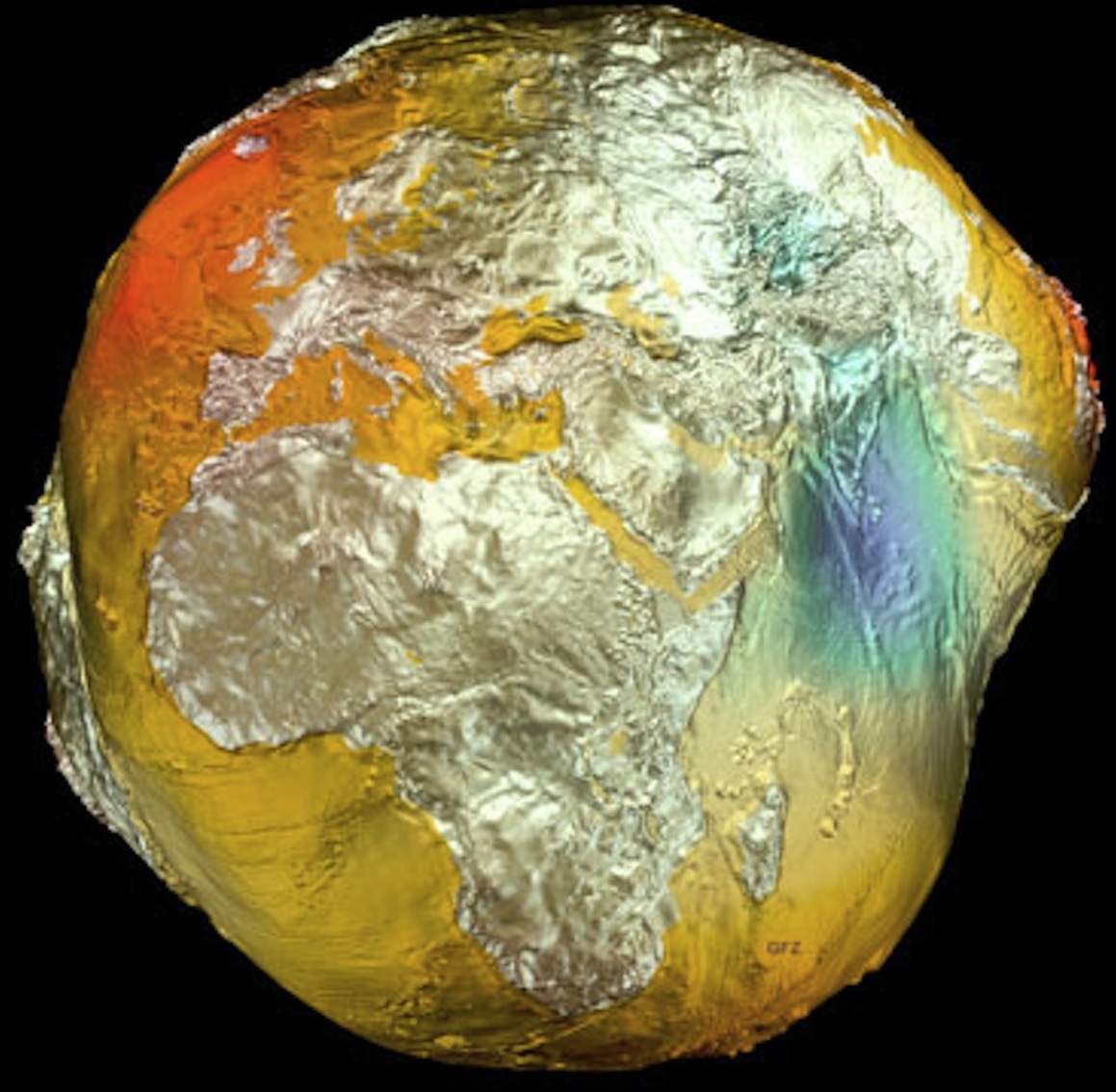 Newton had proposed that the Earth was not round (like an orange) but flattened at the poles (a grapefruit) but Cassini thought it was more like a lemon. In 1735 the French Academy of Sciences, sent an expedition under Pierre Bouguer, and Charles Marie de la Condamine,to Peru to reach some conclusion at the shape of the Earth around the equator by measuring a degree of a meridian of longitude near the equator. This expedition had many difficulties and adventures since their triangulation to take the measures was over the Andes mountains. It was to take 10 years before they had their results. Pierre Louis Moreau de Maupertuis had played a big part in persuading the Academy of Sciences to send the expedition to Peru. In 1736, he convinced the Academy and the government of King Louis XV to send another complimentary expedition to the Arctic. This was to go to Lapland and be based at Tornea in Finland. They were equipped among other things with a Reaumur thermometer and and iron replica of the standard toise (then the French unit of measurement). They found that the iron toise only measured a toise when their Reaumur thermometer was at 15 degrees above zero. Therefore the wooden surveying rods had to be adjusted to fit the standard toise in a specially heated room. They found after making their measurements and then doing the calculations that in Lapland an arc of one degree along the meridian measured 57,395 toises, whereas in Franch Picard had measured it as 57,060 toises. So the Earth was flattened at the poles. (A grapefruit). A few years later, the measurements from the Peru expedition confirmed this.
Newton had proposed that the Earth was not round (like an orange) but flattened at the poles (a grapefruit) but Cassini thought it was more like a lemon. In 1735 the French Academy of Sciences, sent an expedition under Pierre Bouguer, and Charles Marie de la Condamine,to Peru to reach some conclusion at the shape of the Earth around the equator by measuring a degree of a meridian of longitude near the equator. This expedition had many difficulties and adventures since their triangulation to take the measures was over the Andes mountains. It was to take 10 years before they had their results. Pierre Louis Moreau de Maupertuis had played a big part in persuading the Academy of Sciences to send the expedition to Peru. In 1736, he convinced the Academy and the government of King Louis XV to send another complimentary expedition to the Arctic. This was to go to Lapland and be based at Tornea in Finland. They were equipped among other things with a Reaumur thermometer and and iron replica of the standard toise (then the French unit of measurement). They found that the iron toise only measured a toise when their Reaumur thermometer was at 15 degrees above zero. Therefore the wooden surveying rods had to be adjusted to fit the standard toise in a specially heated room. They found after making their measurements and then doing the calculations that in Lapland an arc of one degree along the meridian measured 57,395 toises, whereas in Franch Picard had measured it as 57,060 toises. So the Earth was flattened at the poles. (A grapefruit). A few years later, the measurements from the Peru expedition confirmed this.By the time of the commemorative stamp, when satellites were surveying the Earth, it was discovered that the Earth is not so regular a shape at all. There is a big dip in the Asia Pacific region - around Singapore. The Earth is more like a potato. Diagram on right shows the "potato" Earth.
Achromatic lenses
Achromatic lenses which reduced chromatic aberration - the coloured fringes caused by the different wavelengths of light scattering as they passed through the glass, were developed in the 18th century.
Achromatic lenses were made by passing the light through different materials. The original inventor was Chester Moor Hall, a barrister. His achromatic lens was made from two lenses sandwiched together, a convex lens of crown glass and a concave lens of flint glass. In 1733, he commissioned two different opticians each to make one of the lens, but by chance they both sub-contracted the work to the same man, George Bass. Chester Moor Hall then continued to keep his invention secret.
Some twenty years later, Bass told optician John Dollond about the achromatic lens he had made. Dollond's son Peter, saw the commercial advantages and once his father had made the test lenses, patented the invention. Chester Moor Hall twice attempted to challenge the patent on the grounds that he was the inventor, but lost his case on the grounds that the person who should profit by the invention was the one who benefited the public by it, not the one who kept it locked in his desk draw.
Achromatic lenses changed the design of refractor telescopes which could now be portable, or more easily mounted for greater precision in direction.
The Sicilian astronomer Giuseppi Piazzi came to England to order an achromatic refractor from London instrument maker Jesse Ramsden. The telescope which had a 5 ft. focal length was fitted in an alt-azimuth mounting and the position of the telescope was measured on circular scales. The whole instrument which was called the "Palermo circle" was designed as rigidly as possible for accuracy.
The Herschels
While Piazzi was waiting for Jesse Ramsden to get on with his telescope, (Ramsden was notoriously slow at finishing anything), he visited Caroline and William Herschel and their latest, largest telescope.
William Herschel had been a musician in the army in Hanover (then part of Britain) and moved to Britain and settled in Bath. Bath was the major resort of those wealthy enough to afford it, so he could be sure of a demand for playing and teaching music. He was joined by his brother Alexander and his sister Caroline. Caroline was a small mousy woman who had been forced to stay at home keeping house for her domineering mother. Her brothers replaced her services to her mother by a maid, and took her to Bath to keep house for them. Now Caroline had a chance to blossom, she become a talented singer in demand for performances in her own right - she also shared her brothers' interest in astronomy.
Increasingly William Herschel's hobby of astronomy took over their home, part of a rented terraced house shared with another family, 19 New King Street, Bath, which is now the Herschel museum. Alexander helped build William's telescopes and Caroline helped with the observations and data. The Herschels started making bigger and bigger reflecting telescopes, bigger than anyone had made before.
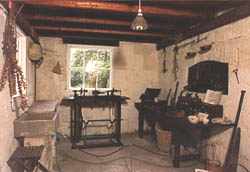 alt="The Herschel's kitchen workshop in Bath">They made a successful 18-inch reflector, then attempted to make a telescope with a mirror three feet in diameter that would have three times the light-gathering power of their 18 inch. They tried to cast the mirror themselves in the scullery of the house which led off from the kitchen at the back. They made the mould with the help of a friend William Watson, out of horse poo (which was often used for this sort of thing). Caroline had the horrid job of sieving the poo and getting it prepared. Then they poured in the hot molten metal. The mould cracked and the hot metal spilled out all over the floor exploding flagstones and chasing the Herschels into the garden. While we were visiting in 2001, the decorators were in, and when I was exclaiming "There are the famous cracked tiles in the scullery!" the lady showing me round was reminded to tell the workman "not to replace the cracked tiles!"
alt="The Herschel's kitchen workshop in Bath">They made a successful 18-inch reflector, then attempted to make a telescope with a mirror three feet in diameter that would have three times the light-gathering power of their 18 inch. They tried to cast the mirror themselves in the scullery of the house which led off from the kitchen at the back. They made the mould with the help of a friend William Watson, out of horse poo (which was often used for this sort of thing). Caroline had the horrid job of sieving the poo and getting it prepared. Then they poured in the hot molten metal. The mould cracked and the hot metal spilled out all over the floor exploding flagstones and chasing the Herschels into the garden. While we were visiting in 2001, the decorators were in, and when I was exclaiming "There are the famous cracked tiles in the scullery!" the lady showing me round was reminded to tell the workman "not to replace the cracked tiles!"
The Herschels concentrated on the mysterious fuzzy blobs which could be seen now telescopes had improved. As telescopes got better, more and more faint fuzzy blobs, like luminous clouds or "nebula" could be seen. Some of these were comets. To help distinguish comets from other nebulae, French astronomer Charles Messier, compiled a catalogue. The nebulae in his catalogue still have his numbers eg. M.1., M.42 etc. The Herschels got a copy of his catalogue in 1781.
Caroline found many comets herself - although at first only William got the credit for their new discoveries. In 1781 the Herschels thought they had found a new comet. William carefully noted its increasing size as he thought it approached Earth. But when astronomers in other observatories checked his observations they found that the Herschels had discovered a new planet.
William hastily revised his data. The Herschels called the new planet Georgium Sidus - George's Star, after King George III, but this was not a name popular in countries over which King George did not reign. Many astronomers thought the planet should be called "Herschel". The name that was finally accepted was suggested by Bode, - Uranus, after the Greek God of Heaven who was castrated by his son Chronos (Saturn to the Romans). The rings were not discovered until 1977, if Bode had known about them perhaps he might have changed his mind. Also the Herschels might not have started the tradition of naming Uranus's moons after fairies, when they discovered Titania and Oberon in 1787. More on Uranus.
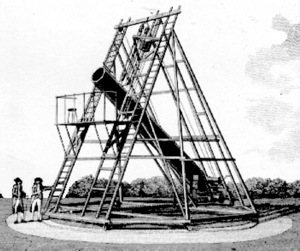 The Herschel's efforts to name the new planet after their king had been a tactful move. George III was interested in science and had his own astronomical observatory at Kew. He gave the Herschels a grant which enabled them to build the world's largest reflector telescope, by their home in Slough, with a 48 inch mirror that weighed a ton in a tube forty feet long. To reach the eyepiece they had to climb a scaffolding that rose 50 feet into the air. By now William had married and had a son. Caroline had been given her own income from the King who recognised her acheievements as an astronomer in her own right, so she was able to have her own home and independence, but still worked with her brother. While he observed, she made the notes. However she also did her own observing and discovered several comets.
The Herschel's efforts to name the new planet after their king had been a tactful move. George III was interested in science and had his own astronomical observatory at Kew. He gave the Herschels a grant which enabled them to build the world's largest reflector telescope, by their home in Slough, with a 48 inch mirror that weighed a ton in a tube forty feet long. To reach the eyepiece they had to climb a scaffolding that rose 50 feet into the air. By now William had married and had a son. Caroline had been given her own income from the King who recognised her acheievements as an astronomer in her own right, so she was able to have her own home and independence, but still worked with her brother. While he observed, she made the notes. However she also did her own observing and discovered several comets.
Pulleys and gears enabled the telescope to be turned and lifted into position, and the platform raised so the astronomer could look through the eyepiece at the end of the tube as described on page 8. In the pitch dark the structure was hazardous. When Piazzi was visiting them, he fell off the ladder and broke his arm.
In 1789, the Herschels discovered two more of Saturn's satellites, Mimas and Enceladus. Piazzi's ordeal in England paid off on the 1st January 1800 when while surveying the sky with Ramsden's telescope he made the first discovery of a minor planet between Mars and Jupiter, which he called Ceres.
The Herschel telescope was the biggest in the world until William Parson, Third Earl of Rosse, completed his 72-inch reflector in Ireland in 1845.
With these large telescopes it was noticed that some of the nebulae which were not comets were irregular clouds like the Orion nebula M.42 which can be seen below Orion's "belt", but more and more of a different type were being found. Small, elliptical in shape. In many of these such as the largest in the northern hemisphere's skies, M.31 (in Andromeda), spiral arms radiating from the centre could be discerned. The nature of these diffuse elliptical spirals was controversial. Some speculated, like the philosopher Kant, that these were island universes of stars and the Milky Way was just one of these in which we happened to live, scattered through eternity. The establishment view was that the Milky Way was the centre of the whole universe and the spiral nebulae were solar systems in the making.
Two typical types of nebulae are illustrated in 19th century astronomy book. One is the Orion Nebula (M.42) which we now know is a cloud of gas and dust in our own galaxy in which new stars are forming, the other is Andromeda (M.31) which we now know is another galaxy similar to our own, the Milky Way.
Until the distances of the spiral nebulae could be measured, the possibility that they were other star systems remained speculative and controversial. They were thought to be new solar systems forming around new stars. But by the beginning of the 19th century, optical astronomy had gone as far as it could go on its own.
The next developments would be made with the use of spectroscopy, and photography - William Herschel's son John invented the word photography, and one of his photos was of the by then derelict telescope at Slough.
The Astronomers Drinking Song
This was apparently sung at a dinner in 1798 given by the Mathematical Society in London, to honour their solicitor, Mr. Fletcher.
The Mathematical Society was founded in 1717 in Spitalfields in the East End of London, where a number of Hugenots and Jewish refugees had settled. Unlike the many "Gentlemen's Societies" founded in the early 18th century, the Mathematical Society was intended for working people "the studious artisan". One of its rules was - "it is the duty of every member, if he be asked any mathematical or philosophical question by another member, to instruct him in the plainest and easiest manner he is able." Those that refused to do this were fined one penny.
Members also included many eminent mathmaticians including for example, Nicholas Saunderson, Lucasian Professor of Mathematics at Cambridge (who had been blind since a child).
In 1798, the Mathematical Society started giving lectures, open to the public for an admission charge of one shilling payable at the door.
An action was brought against the society for £5000 for holding unlicensed public exhibitions for payment at the door. Mr. Fletcher, the solicitor, successfully defended the Society. A collection was made by the members, but he refused payment so a dinner was held in his honour.
The astronomer's drinking song had been tidied up if not invented, by mathmatician and historian Augustus De Morgan who claimed to have found it amonst the papers of a deceased friend.
By 1845, the Mathematical Society was failing, so an arrangement was made with the Royal Astronomical Society to make all remaining 19 member Fellows of the Royal Astronomical Society. The last President of the Mathematical Society was Benjamin Gompertz, who had been elected to membership of the Mathematical Society when he was only 16, bending the rules that members had to be over 21.
The RAS was concerned that the new Fellows from the Mathematical Society should be "of that class of educated men who could associate with the Fellows of the Astronomical Society on terms agreeable to all parties." De Morgan, one of the organisers of the merger (and founder of a new Mathematical Society in 1866) claimed "We found that the artisan element had been extinct for many years; there was not a man but might, as to education, manners, and position, have become a Fellow in the usual way."
Science and mathematics were considered suitable pursuits for ladies in the 18th century but they only had a chance of attending meetings of societies on "ladies nights" by invitation from a member, or, in London they could go to lectures at the Royal Institution. The British Astronomical Association, which admitted amateurs on the same terms as professionals, was the first scientific organisation to admit women members on equal terms. It is still regarded for enthusiastic amateurs - those doing astronomy for a hobby. In astronomy the dividing line between hobbyist and professional is even now, not clearly drawn.
The astronomers drinking song gives us a summary of astronomy at the end of the 18th century:
Whoe'ver would search the starry sky,
Its secrets to divine, sir,
Should take his glass - I mean, should try
A glass or two of wine, sir!
True virtue lies in golden mean,
And man must wet his clay, sire;
Join these two maxims, and 'tis seen
He should drink his bottle a day, sir!Old Archimedes, reverend sage!
By trump of fame renowned, sir,
Deep problems solved in every page,
And the sphere's curved surface found, sir;
Himself he would have far outshone,
And borne a wider sway, sir
Had he our modern secret known,
And drank a bottle a day, sir!When Ptolemy, now long ago,
Believed the earth stood still, sir!,
He never would have blundered so,
Had he but drunk his fill, sir:
He'd then have felt it circulate,
And would have learnt to say, sir,
The true way to investigate
Is to drink your bottle a day, sir!Copernicus, that learned wight,
The glory of his nation,
With draughts of wine refreshed his sight,
And saw the earth's rotation;
Each planet then its orb described,
The moon got under way, sir;
These truths from nature he imbibed
For he drank his bottle a day, sir!(vodka more likely)
The noble Tycho placed the stars,
Each in its due location;
He lost his nose by spite of Mars,
But that was no privation;
Had he but lost his mouth, I grant
He would have felt dismay, sir,
Bless you! he knew what he should want
To drink his bottle a day, sir!He lost his nose as a student in a duel with another student in an argument on who was the better mathematician and after that wore a gold alloy prosthetic nose which was never comfortable and made him bad tempered. Later on when he was moving to his new observatory, his pet elk drunk a barrel of beer and fell down the stairs.
Cold water makes no lucky hits;
On mysteries the head runs:
Small drink let Kepler time his wits
On the regular polyhedrons:
He took to wine, and it changed the chime,
His genius swept away, sir,
Through area varying as the time
At the rate of a bottle a day, sir!(a reference to Kepler's model of the solar system made up from 3d regular geometric models - history shows it to have been a pointless waste of time and effort - he is more famous for his improved telescope and discovering and calculating the ecliptical orbits of the planets)
Poor Galileo, forced to rat
Before the Inquisition,
E pur si muove was the pat
He gave them in addition:
He meant, whate'er you think you prove,
The earth must go its way, sirs;
Spite of your teeth I'll make it move,
For I'll drink my bottle a day, sirs!Great Newton, who was never beat
Whatever fools may, think, sir;
Though sometimes he forgot to eat,
He never forgot to drink, sir:
Descartes took nought but lemonade,
To conquer him was play, sir;
The first advance that Newton made
Was to drink his bottle a day, sir!This was just Brit patriotism supporting Newton's planetary theories against the French Descartes (who was indeed off-beam in his vortex theory of planetary motion). However Newton is the only Brit who gets a mention in the song.
D'Alembert, Euler, and Clairaut,
Though they increased our store, sir,
Much further had been seen to go
Had they tippled a little more, sir!
Lagrange gets mellow with Laplace,
And both are wont to say, sir,
The philosophe who's not an ass
Will drink his bottle a day, sir!Astronomers! What can avail
Those who calumniate us;
Experience can never fail
With such an apparatus:
Let him who'd have his merits know
Remember what I say, sir;
Fair science shines on him alone
Who drinks his bottle a day, sir!How light we reck of those who mock
By this we'll make to appear, sir,
We'll dine by the sidereal clock
For one more bottle a year, sir:
But choose which pendulum you will,
You'll never made your way, sir,
Unless you drink - and drink your fill, -
At least a bottle a day, sir.the sidereal clock gives you another 4 minutes a day
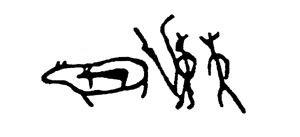 |